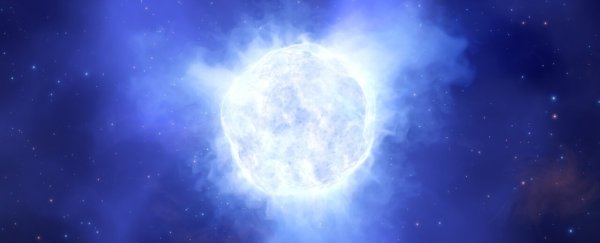Massive stars aren't like your car keys. They're not going to disappear under a pile of mail on your kitchen counter, or end up in the washing machine. But a massive star that astronomers were observing for a decade now appears to be totally missing.
The star, in the very late stages of its lifespan, was shining brightly between 2001 and 2011, when different teams of astronomers were regularly observing it to obtain more information on how stars end their lives. But in observations obtained in 2019, the star's signature was completely absent.
Then the mystery deepened. When researchers looked back through archival data from 2011 and 2016, looking for some clue as to the star's disappearance, its light was present in the former, but missing in the latter. Somehow, after 2011, the star vanished without a trace.
And there's a really exciting possibility - that the star collapsed down into a black hole, without the supernova that has previously been thought a necessary component of such events.
"If true," said astrophysicist Andrew Allan of Trinity College Dublin in Ireland, "this would be the first direct detection of such a monster star ending its life in this manner."
It's a little hard to figure out exactly what happened, though. It all went down in a dwarf galaxy called PHL 293B, 75 million light-years away. At that distance, making out individual stars is impossible - we simply don't have the technology.
However, there's a type of star called a luminous blue variable that has a recognisable light signature. These stars are massive - on the supergiant or hypergiant scale - and at the end of their lives. As such, they are extremely bright and unstable, and their light can vary dramatically in both brightness and spectrum as they undergo outbursts and eruptions.
In the earlier observations of the dwarf galaxy, this signature was present, indicating a star between 2.5 and 3.5 million times as bright as the Sun. So when the team turned all four of the European Southern Observatory's Very Large Telescope optical telescopes towards PHL 293B in August 2019, the absence was shocking.
"It would be highly unusual for such a massive star to disappear without producing a bright supernova explosion," Allan said.
In recent years, however, evidence has started to emerge that stars can indeed collapse directly into black holes without undergoing a supernova explosion. In 2017, a paper was published on a similar phenomenon in a galaxy 22 million light-years away - a red giant star that brightened suddenly before blinking out of existence, leading astronomers to hypothesise that the star had undergone a failed supernova before collapsing.
Based on their observations, the team believes the star in PHL 293B was in an eruptive state between 2001 and 2011. From this point, there are two main possibilities.
The first is that the star grew slightly dimmer, and became shrouded in a cloud of dust as it ejected material into the space around it - much like the dust cloud that may (or may not) have obscured Milky Way's red giant star Betelgeuse earlier this year. In this scenario, the star could have continued erupting behind its cloud of dust - we just can't see it any more because, well, cloud of dust.
Near-infrared observations between 2009 and 2019 ruled out a cloud of hot dust, but mid-infrared observations that could confirm or rule out cooler dust are yet to be taken, so this scenario is still very much on the table.
In the other scenario, the eruption could have been the star's death throes, ending abruptly at some point after 2011 as the star collapsed into a black hole. If the star had an initial mass between 85 and 120 times that of the Sun - just below the range of a pair-instability supernova, in which the star is blown to smithereens instead of collapsing.
It's not impossible that the star underwent an undetected supernova, but such a massive star as a luminous blue variable would be expected to produce a supernova afterglow that shines in the sky for at least five years following the kaboom.
"We may have detected one of the most massive stars of the local Universe going gently into the night," said astrophysicist Jose Groh of Trinity College Dublin.
It's impossible to know for certain with the current data. Only future observations across a range of wavelengths can shed light on the mystery of the missing star.
The research has been published in the Monthly Notices of the Royal Astronomical Society.
